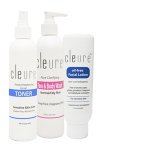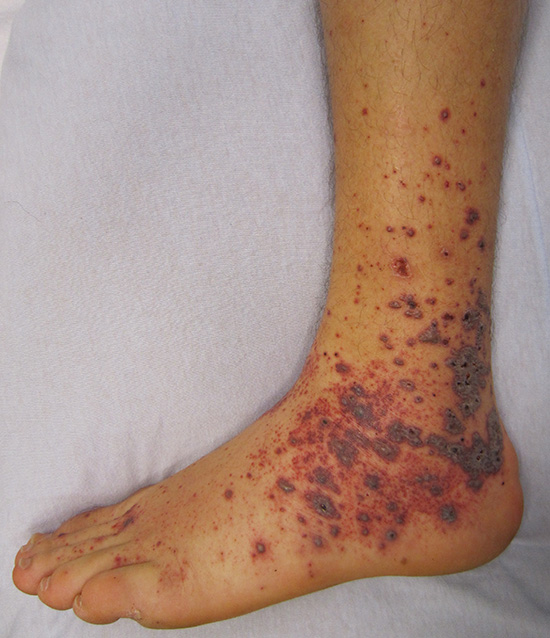Allergic Reaction Rashes
Treating an Allergic Skin Rash Naturally
Allergic reaction rashes can occur as a result of environmental factors, certain foods, certain medications, and insect stings. Learn how to prevent them, and how you can treat an allergic rash naturally.
The rash will appear in different ways, depending on the trigger that caused the reaction.
Why Does an Allergic Skin Rash Happen?
Allergens are considered foreign substances or invaders to the body's otherwise healthy functions. When an allergen is detected, the body works to defend itself by alerting the immune system that the body is in danger.
The immune system naturally overreacts to the foreign substance, which then shows up as a rash; indicating an allergic reaction to something in the air, food, medication, or even exposure to a bee or insect sting of some kind.
Allergens can include, but are not limited to:
- Peanuts
- Eggs
- Seafood shrimp, lobster, scallops to name a few
- Dust mites
- Fragrances
- Animal dander
- Poison ivy, sumac, or poison oak
- Insect stings wasps, bees
- Plants, trees, weeds, grass
- Pollen
- Cockroaches
- Food preservatives
- Bacteria
- Metal - nickel
- Medications most common are seizure medications and some antibiotics
- Latex balloons, rubber bands, condoms, rubber gloves
Each person responds differently to allergens and can develop different types of rashes due to allergens.
What Do Allergic Reaction Rashes Look Like?
The three most common rashes are atopic dermatitis or eczema, hives or urticaria, and dermatitis herpetiformisor lesions.
Atopic Dermatitis - Eczema
Eczema is the most well known name for atopic dermatitis and is a reaction most often to an allergic reaction to food. Children experience this type of allergic reaction more than adults.
Foods that can cause eczema include dairy, chocolate, nuts, citrus, honey, or seafood. Symptoms of this rash include scaly skin, red irritated skin, itching, and swelling. Atopic dermatitis may appear on the forehead, face, ears, neck, or scalp.
Hives Allergic Reaction Urticaria
Hives, which are raised bumps or lesions on the surface of the skin, appear as a result of stress, exposure to toxins, ingesting certain foods or by simply coming in contact with specific foods. The hives allergic reaction can show up as soon as one hour after coming into contact with the allergen.
The raised bumps can itch and be red in color. Swelling is sometimes associated with the appearance of hives and can occur in the ears, lips, tongue, or eyes. If swelling of the tongue occurs, it's best to see a doctor immediately.
Allergic reaction rashes like these can be especially painful if the hives occur on top of the previous ones. See Hives Causes for more tips on avoiding a breakout.
It's possible for a hives allergic reaction to last a few days or even as long as two weeks, depending on whether you've come into contact with the offending allergen again during the healing period. We recommend Hive Away as a safe, natural treatment option.
Dermatitis Herpetiformis or Lesions
An allergic reaction to gluten causes lesions or dermatitis herpetiformis to appear on the buttocks, knees, scalp, or elbows. The lesions will consistently remain unless gluten is eliminated from the diet completely.
They look like blisters, are red in color, and can contain fluid. When scratched, they can seep, crust over and leave marks on the skin even after they're healed.
Dermatitis herpetiformis is rare, but is commonly found in people with Celiac disease. Gluten is found in many products on the market today, so it's a challenge to stop eating it, but it can be done.
Natural Treatments for Treating Allergic
Reaction Rashes
Make Changes in Your Diet
Once you've determined which foods are causing your allergic reaction, eliminate them from your diet and look for alternative food sources to replace those offending foods. Keep a daily food journal and note what foods you've eaten when you experience the skin rash.
Gluten is one allergen that, when eliminated, the blisters or lesions will disappear completely for those who are allergic to gluten. Look for gluten free foods and opt for making your own bread and other foods at home from scratch to avoid gluten.
Those who suffer from latex allergies should also avoid certain foods due to the fact that for some reason the body gets confused and treats the proteins in these foods as allergens, causing allergic reaction rashes.
These foods include bananas, hazelnuts, avocados, pineapple, potatoes, melons, kiwi fruit, tomatoes, wheat, figs, strawberries, chestnuts, peaches, papaya, cherries, grapes, and plums, to name a few.
Cleansing Regimen for Allergies and Skin Rashes
Conducting a homemade body cleanse periodically can clean your body of toxins and potentially harmful allergens and in turn protect you from allergic reaction rashes developing on the skin.
The basics are to drink a lot of fresh clean water, get at least 8 hours of rest each night, enjoy the sunshine and fresh air outside, and to avoid some foods and beverages for a time.
You'll enjoy whole, raw fruits and vegetables and juices made from these whole foods during this time of cleansing. Your body's immune system will be boosted and have the ability to fight infection and allergens, which hopefully, will keep the rashes from developing.
Prevent Allergic Skin Rash - Use Hypoallergenic Products
Does the ingredients in your health and beauty products really make a difference? Yes, it is very important! So many products on the market today contain ingredients like fragrance and synthetic chemicals that can cause allergic reactions both on the skin and inside the body.
Switching to hypoallergenic products like shampoo, conditioner, makeup, lip balm, facial cleasners, and lotions may solve your problem with contact dermatitis or other skin rashes. Cleure is an excellent product line for people experiencing allergic skin rashes or who have sensitive skin.
Exercise Regularly to Prevent Allergic Reaction Rashes
Exercise purges the body of toxins because you sweat them out when you get moving, but it's important to do a few things in addition to exercising to help prevent skin rashes.
Drink plenty of water during your workout so salt crystals don't have a chance to form once you've stopped exercising. Lubricate any areas that tend to break out in a skin rash before beginning your exercise so that those areas have less chance of breaking out.
There are people however who are allergic to exercise. Talk to your physician to determine whether or not your reaction to exercise is serious enough to cease intense exercise altogether.
If strenuous exercise is too much for you, gentler forms of movement like Tai Chi or Y-Dan (a very simple and helpful Chinese exercise) can provide you with all the benefits of healthy movement without the effects of more aerobic exercises.
Natural Remedies for Allergic Reaction Rashes
Sometimes it is impossible to know exactly what caused your allergic skin rash. Some people may even break out into more of a rash from the side effects of using creams and lotions that are supposed to heal your rash!
I've had this happen more times than I can remember. The latest was when I developed an eye infection which didn't go away, so I finally got medication for it and the medication made it worse!
If you are very sensitive to a lot of medications, you may want to explor natural remedies for allergic reaction rashes, such as Hive Away , a very effective natural treatment for any kind of skin rash which has no side effects.
Allergic Reaction Rashes Conclusion
You can control or eliminate allergic reaction rashes by targeting the offending allergen or allergens and then treating it with the natural treatments we've outlined above. You'll enjoy clearer skin and fewer breakouts while treating your body right!
Home > Pictures of Rashes > Allergic Reaction Rashes









New! Comments
Share your thoughts about what you just read! Leave me a comment in the box below.